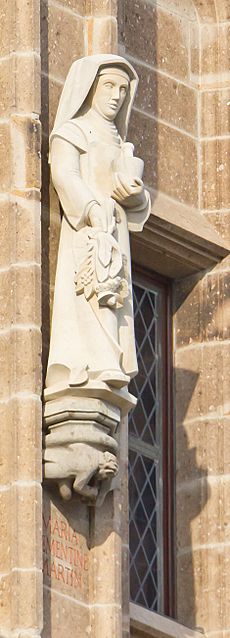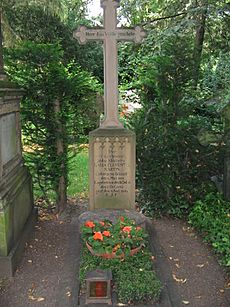Maria Clementine Martin facts for kids
Maria Clementine Martin, whose birth name was Wilhelmine Martin, was born on May 5, 1775. She passed away on August 9, 1843. Maria Clementine Martin is famous for inventing Klosterfrau Melissengeist. This product is an herbal extract that contains alcohol.
Contents
Early Life and Convent Years
Maria Clementine Martin was born in Brussels. Her parents were Johann Heinrich de Martin and Christine de Martin von Mergenthal. In 1783, her family moved to Jever.
When she was 17, in 1792, Maria joined a convent in Coesfeld. It was called the Sankt Anna convent, part of the Order of the Annunciation of the Blessed Virgin Mary.
However, in 1803, a new law called the Reichsdeputationshauptschluss led to many monasteries being taken over by the government. This process was called secularization. Because of this, the Sankt Anna monastery was closed.
Maria then moved to another monastery in Glane, near Gronau. This monastery was also home to Franciscan Sisters. In 1811, a rule by Napoleon caused all Franciscan convents to be closed. This meant the sisters faced financial hardship. They received only small yearly payments.
Maria Clementine Martin eventually traveled to Tienen in the Province of Brabant. Records show she stayed there until 1815.
Helping Soldiers After Battle
After the Battle of Waterloo on June 18, 1815, Maria Clementine Martin is said to have helped wounded German soldiers. These soldiers were under the command of Gebhard Leberecht von Blücher. Some stories even say she helped during the battle itself.
While some details might be legends, it is believed she worked in Prussian military hospitals. Because of her help, King Frederick William III honored her. He gave her a yearly payment of 160 thalers for the rest of her life.
From 1815 to 1821, her exact whereabouts are not fully known. Maria herself said she lived for eight years in a Carmelite convent in Brussels. However, there are no other records to confirm this.
It is certain that she lived in Münster from 1821 to 1825. She stayed in a house owned by the Domkapitel Münster. Not much is known about her work there.
Moving to Cologne and Starting a Business
In 1825, Maria Clementine Martin moved to a house in Cologne. She likely cared for an elderly priest named Hermann Gumpertz, who owned the house.
In this building, she started making Eau de Cologne. She used a simple distillation process. On November 6, 1825, she advertised her product in the Kölnische Zeitung newspaper.
Her company was officially started on May 23, 1826. It was registered as "Maria Clementine Martin Klosterfrau."
In 1827, Maria moved to a new house in Domhofgasse 19. She rented it from the Cologne Cathedral Chapter and later bought it in the 1830s. From this new location, she began advertising a Carmelite spirit she made. This advertisement appeared in the Kölnische Zeitung on June 17, 1827.
Besides her cologne, she also offered lavender water. She also sold a product called vinegar de quatres voleurs. This product was believed to protect against serious diseases. Its name came from a story about thieves during wars. They robbed bodies on battlefields. They supposedly used this special vinegar to protect themselves from infections like the plague.
Creating Lemon Balm Spirit
On July 5, 1828, Maria Clementine Martin asked the Cologne government to check her lemon balm water. She wanted them to confirm its quality. She said she had worked as a "manufacturer" in a convent that made money by producing Carmelite water. She also claimed she learned the secret recipe during her eight years in a Carmelite convent in Brussels.
However, some historians doubt these claims. There is no proof that Carmelite or Melissa spirit was made in the convents she mentioned. Also, there is no evidence she belonged to the Brussels Carmelite nuns. Still, it is clear that Maria could make a lemon balm spirit. It was similar to the popular Carmelite spirit from Regensburg.
The authorities in Koblenz decided not to test her product. They said a chemical test was not possible because similar products existed. They also noted that any pharmacist could make a similar product called Alcoolat de melissa compositum. This product was already approved as a medicine.
Using the Prussian Eagle Symbol
About a year after this decision, Maria Clementine Martin wrote to King Friedrich William III. She asked for permission to use the Coat of arms of Prussia on her products. She reminded him of her help to soldiers after the Battle of Waterloo.
On November 28, 1829, the King granted her this special privilege. This made her one of the few companies in Cologne allowed to use the royal coat of arms. Other companies, like Johann Maria Farina gegenüber dem Jülichs-Platz, had tried and failed to get the same advantage.
In the following years, Farina complained about other companies using the Prussian eagle without permission. The authorities did not always help Farina at first. Other companies also complained about Maria Martin. They said she was using the entire Mittleres Wappen Preußens, not just the eagle. This full coat of arms included a crown and other symbols.
However, Maria Martin managed to get approval to use the full coat of arms. She wrote to the Cologne government and a chief president in July 1830. This allowed her to keep her special advantage over competitors.
Standing Out from Competitors
Maria Martin's main product, Melissengeist, was not unique in its ingredients. Yet, she was very successful in making her company well-known. She also protected her market position, even with some challenges.
On October 17, 1831, she registered her "factory mark" with the City of Cologne. In 1832, she asked the Prussian government for the exclusive right to make and sell Melissengeist. She also wanted it to be recognized as a medicine. Until then, it was only allowed to be sold as a perfume.
Even though the Cologne authorities supported her, the government in Berlin rejected her request on March 15, 1834. They again said that pharmacists should not be restricted. Pharmacists could prepare the product by prescription and were the only ones allowed to make medicines.
So, lemon balm spirit could officially only be sold as a cosmetic. This meant competition in this area could not be controlled in Maria's favor. However, Melissengeist products were often advertised with hints of medicinal uses. This led to actions against competitors, but not against Maria. She had some protection, partly because of the royal permission to use the coat of arms. In 1835, Maria successfully reported a competitor. This competitor was selling Carmelite spirit from Regensburg with instructions for medicinal use, even though Maria herself used similar papers.
To become known internationally, she participated in an Art and Industry Exhibition in Cologne. This event took place from May 27 to July 4, 1838. Even as late as August 30, 1842, advertisements for her melissa spirit appeared in the Kölnische Zeitung.
Shortly before her death, on April 5, 1843, she wrote her will. She left her entire business to "Peter Schaeben, who lives with me." She trusted him to continue her work faithfully. Maria Clementine Martin died on August 9, 1843, in Cologne, at the age of 68. She was buried at the Melaten-Friedhof with many people attending. Her grave is now a protected historical site.
Her product received its first award after her death. This was in August 1843 at the London World's Fair, which happened between May and October 1851. Her assistant, Peter Gustav Schaeben, took over the business. He greatly expanded it and sold the products all over the world.
Images for kids




